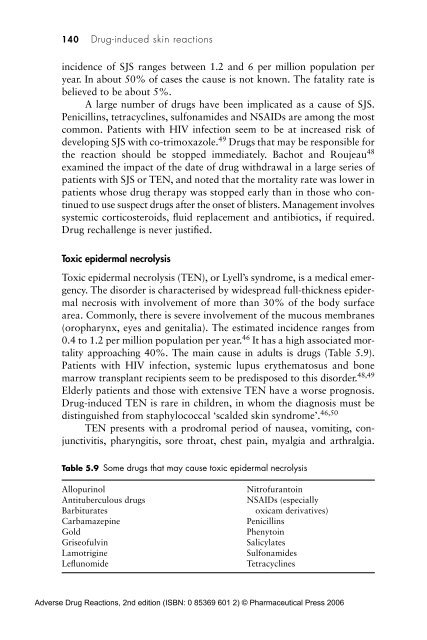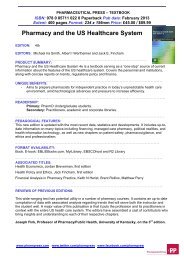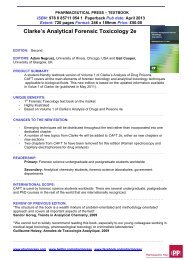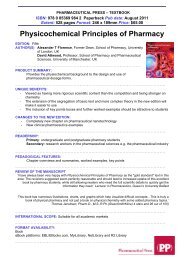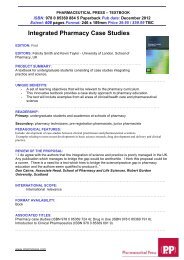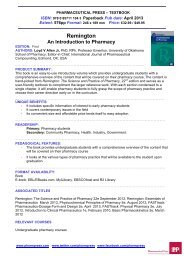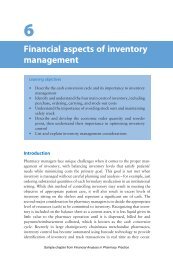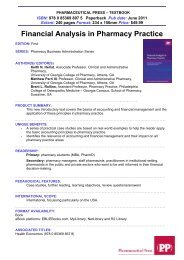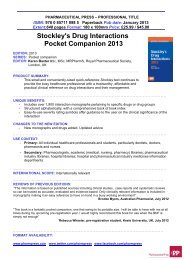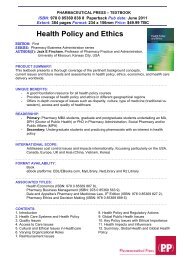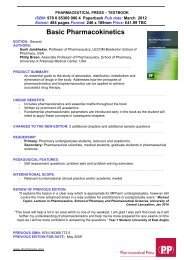Drug-induced skin reactions - Pharmaceutical Press
Drug-induced skin reactions - Pharmaceutical Press
Drug-induced skin reactions - Pharmaceutical Press
Create successful ePaper yourself
Turn your PDF publications into a flip-book with our unique Google optimized e-Paper software.
140 <strong>Drug</strong>-<strong>induced</strong> <strong>skin</strong> <strong>reactions</strong><br />
incidence of SJS ranges between 1.2 and 6 per million population per<br />
year. In about 50% of cases the cause is not known. The fatality rate is<br />
believed to be about 5%.<br />
A large number of drugs have been implicated as a cause of SJS.<br />
Penicillins, tetracyclines, sulfonamides and NSAIDs are among the most<br />
common. Patients with HIV infection seem to be at increased risk of<br />
developing SJS with co-trimoxazole. 49 <strong>Drug</strong>s that may be responsible for<br />
the reaction should be stopped immediately. Bachot and Roujeau 48<br />
examined the impact of the date of drug withdrawal in a large series of<br />
patients with SJS or TEN, and noted that the mortality rate was lower in<br />
patients whose drug therapy was stopped early than in those who continued<br />
to use suspect drugs after the onset of blisters. Management involves<br />
systemic corticosteroids, fluid replacement and antibiotics, if required.<br />
<strong>Drug</strong> rechallenge is never justified.<br />
Toxic epidermal necrolysis<br />
Toxic epidermal necrolysis (TEN), or Lyell’s syndrome, is a medical emergency.<br />
The disorder is characterised by widespread full-thickness epidermal<br />
necrosis with involvement of more than 30% of the body surface<br />
area. Commonly, there is severe involvement of the mucous membranes<br />
(oropharynx, eyes and genitalia). The estimated incidence ranges from<br />
0.4 to 1.2 per million population per year. 46 It has a high associated mortality<br />
approaching 40%. The main cause in adults is drugs (Table 5.9).<br />
Patients with HIV infection, systemic lupus erythematosus and bone<br />
marrow transplant recipients seem to be predisposed to this disorder. 48,49<br />
Elderly patients and those with extensive TEN have a worse prognosis.<br />
<strong>Drug</strong>-<strong>induced</strong> TEN is rare in children, in whom the diagnosis must be<br />
distinguished from staphylococcal ‘scalded <strong>skin</strong> syndrome’. 46,50<br />
TEN presents with a prodromal period of nausea, vomiting, conjunctivitis,<br />
pharyngitis, sore throat, chest pain, myalgia and arthralgia.<br />
Table 5.9 Some drugs that may cause toxic epidermal necrolysis<br />
Allopurinol<br />
Antituberculous drugs<br />
Barbiturates<br />
Carbamazepine<br />
Gold<br />
Griseofulvin<br />
Lamotrigine<br />
Leflunomide<br />
Nitrofurantoin<br />
NSAIDs (especially<br />
oxicam derivatives)<br />
Penicillins<br />
Phenytoin<br />
Salicylates<br />
Sulfonamides<br />
Tetracyclines<br />
Adverse <strong>Drug</strong> Reactions, 2nd edition (ISBN: 0 85369 601 2) © <strong>Pharmaceutical</strong> <strong>Press</strong> 2006


